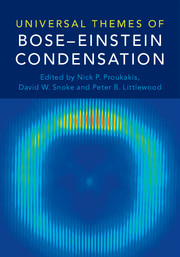Book contents
- Frontmatter
- Contents
- Foreword
- Preface
- Part I Introduction
- Part II General Topics
- Part III Condensates in Atomic Physics
- Part IV Condensates in Condensed Matter Physics
- Editorial Notes
- 19 Bose-Einstein Condensation of Photons and Grand-Canonical Condensate Fluctuations
- 20 Laser Operation and Bose-Einstein Condensation: Analogies and Differences
- 21 Vortices in Resonant Polariton Condensates in Semiconductor Microcavities
- 22 Optical Control of Polariton Condensates
- 23 Disorder, Synchronization, and Phase-locking in Nonequilibrium Bose-Einstein Condensates
- 24 Collective Topological Excitations in 1D Polariton Quantum Fluids
- 25 Microscopic Theory of Bose-Einstein Condensation of Magnons at Room Temperature
- 26 Spintronics and Magnon Bose-Einstein Condensation
- 27 Spin-Superfluidity and Spin-Current Mediated Nonlocal Transport
- 28 Bose-Einstein Condensation in Quantum Magnets
- Part V Condensates in Astrophysics and Cosmology
- Universal Bose-Einstein Condensation Workshop
- Contributors
- Index
- References
24 - Collective Topological Excitations in 1D Polariton Quantum Fluids
from Part IV - Condensates in Condensed Matter Physics
Published online by Cambridge University Press: 18 May 2017
- Frontmatter
- Contents
- Foreword
- Preface
- Part I Introduction
- Part II General Topics
- Part III Condensates in Atomic Physics
- Part IV Condensates in Condensed Matter Physics
- Editorial Notes
- 19 Bose-Einstein Condensation of Photons and Grand-Canonical Condensate Fluctuations
- 20 Laser Operation and Bose-Einstein Condensation: Analogies and Differences
- 21 Vortices in Resonant Polariton Condensates in Semiconductor Microcavities
- 22 Optical Control of Polariton Condensates
- 23 Disorder, Synchronization, and Phase-locking in Nonequilibrium Bose-Einstein Condensates
- 24 Collective Topological Excitations in 1D Polariton Quantum Fluids
- 25 Microscopic Theory of Bose-Einstein Condensation of Magnons at Room Temperature
- 26 Spintronics and Magnon Bose-Einstein Condensation
- 27 Spin-Superfluidity and Spin-Current Mediated Nonlocal Transport
- 28 Bose-Einstein Condensation in Quantum Magnets
- Part V Condensates in Astrophysics and Cosmology
- Universal Bose-Einstein Condensation Workshop
- Contributors
- Index
- References
Summary
We discuss some recent advances in the spin dynamics in photonic systems and polariton superfluids. In particular, we describe how the spin degree of freedom affects the collective behaviour of the half-soliton gas. First, we demonstrate that the anisotropy in the intra- and interspin interaction leads to the formation of a one-dimensional ordered phase: the topologicalWigner crystal. Second, we show that half-solitons behave as magnetic monopoles in effective magnetic fields. We study the transport properties and demonstrate a deviation from the usual Ohm's law for moderate values of the magnetic field.
Introduction
Photonic systems offer great opportunities for the study of quantum fluids, due to the possibility of creation of macroscopically occupied states with well-controlled properties by coherent excitation with lasers, and the full access to the wavefunction of the quantum fluid by well-established optical methods [1]. The main distinctive feature of quantum fluids as compared with classical ones are the topological defects, which, once created, cannot be removed by a continuous transformation. The most well-known example of such defect is a quantum vortex, which can appear in two-dimensional (2D) and three-dimensional (3D) systems. Its analog in one-dimensional (1D) Bose-Einstein condensates (BECs) is a soliton [2]. In fact, solitons are ubiquitous in systems described by the self-defocussing nonlinear Schrödinger equations. Specifically, for Bose gases, they are associated with the excitations of type II of the Lieb and Liniger theory. Spinor BECs (particularly with two pseudospin projections) offer a plethora of nonlinear spin effects, including half-integer topological defects possible in BECs with spin-anisotropic interactions [3]. Recent experimental work reports on the emergent monopole behaviour of half-solitons in the presence of an effective magnetic field [4]. In this chapter, we highlight some theoretical advances concerning not only the dynamics but also the many-body aspects of the physics of half-solitons.
A Topological Wigner Crystal
It is commonly accepted that the Wigner crystal is one of the most simple yet dramatic many-body effects. In the seminal work published in 1931 [5], Wigner showed that as a result of the competition between the long-ranged potential and kinetic energies, electrons spontaneously form a self-organized crystal at low densities, in a state that strongly differs from the Fermi gas. Experimental observations of this effect have been reported in carbon nanotubes [6].
- Type
- Chapter
- Information
- Universal Themes of Bose-Einstein Condensation , pp. 477 - 492Publisher: Cambridge University PressPrint publication year: 2017



